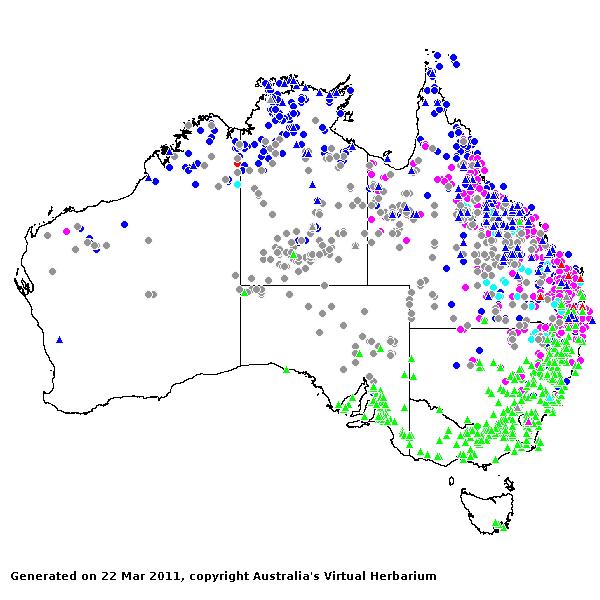Bothriochloa Rev. Gen. Pl. 2: 762 (1891).
Derivation:. From Greek bothros (pit) and chloa (grass), alluding to the pitted glumes.
Taxonomic revisions, nomenclatural references:. S.T.Blake, Papers Dept. Biol. University Qld, 2(3): 24–41 (1944); B.K.Simon, Austrobaileya 1: 455–457 (1982) and Austrobaileya 3: 79–80 (1989).
Key references (keys and floras):. G.Bentham, Flora Australiensis 7: 459–462 (1878) as Pollinia in part; J.W.Vickery, Flora of New South Wales, Gramineae 19: 39–45 (1961); M.Lazarides, Flora of Central Australia 487 (1981); E.E.Henty, Manual Grasses New Guinea 36 (1969); M.Lazarides, Tropical Grasses S.E. Asia 23–24 (1980); J.C.Tothill and J.B.Hacker, Grasses of Southern Queensland 126–131 (1983); J.P.Jessop, Flora of South Australia 4:1984–1986 (1986); B.K.Simon, Flora of the Kimberley Region 1130–1131 (1992); B.K.Simon, Key to Australian Grasses 76–77 (1993); S.W.L.Jacobs and C.A.Wall, Flora of New South Wales 4: 439–441(1993); N.G.Walsh, Flora of Victoria 2: 621–623 (1994); D.I.Morris, Student's Flora of Tasmania 4B: 355–357 (1994); E.Edgar and H.E.Connor, Flora of New Zealand 5: 601–604 (2000); D.Sharp and B.K.Simon, AusGrass (2002); J.P.Jessop, Grasses of South Australia 509–511 (2006); S.W.L.Jacobs, R.D.B.Whalley & D.J.B.Wheeler, Grasses of New South Wales, 4th Ed, 167–170 (2008).
W.D.Clayton & S.A.Renvoize, Genera Graminum (1986), genus (595).
Native and naturalised. 35 species, from warm regions. 9 species in Australia, WA, NT, SA, Qld, NSW, Vic, and Tas. Also New Guinea, Malesia and New Zealand.
Habit. Perennial, rhizomatous or stoloniferous or tufted or decumbent. Leaf blades narrow. Ligule an unfringed membrane to a fringed membrane.
Inflorescence. Inflorescence of spicate main branches (many-jointed `racemes') or paniculate (rarely: the lower `racemes' sometimes branched again at the base), an open panicle with branches ending in racemes of paired spikelets or of digitate or subdigitate racemes or spikes, digitate or subdigitate (the racemes often almost palmate, towards the culm tips) or non-digitate, spatheate or espatheate, a compound pseudo-inflorescence or not a compound pseudo-inflorescence. Spikelet-bearing axes racemes, joints usually with more than 10 spikelet-bearing joints, with heteromorphic spikelets, solitary or paired or clustered, with spikelets in pairs, one sessile, the other pedicelled, disarticulating at joints. Pedicels and rachis internodes with a longitudinal, translucent furrow. Internodes disarticulating transversely, densely long-hairy (often villous) or somewhat hairy or glabrous.
Spikelets. Spikelets dorsally compressed, 2 flowered, with 1 fertile floret, awned, mainly paired (with a terminal triplet), sessile and pedicelled, in pedicelled/sessile combinations; sessile spikelet with lower incomplete floret. Fertile spikelets falling with glumes (and with the joint).
Glumes. Glumes more or less equal, long relative to adjacent lemmas, hairy (towards the base) or hairless, glabrous or scabrous, pointed or blunt (blunt or minutely bifid), awnless, dissimilar (the lower bicarinate and often with a pit on the back, the upper narrower, naviculate). Lower glume two-keeled, convex on back to flattened on back, with a conspicuous pit or not pitted, relatively smooth, 5–9 nerved. Upper glume 1–4 nerved.
Florets. Lower incomplete floret(s) sterile. Lemmas awnless, 0 nerved, more or less equalling fertile lemmas to exceeding fertile lemmas, similar in texture to fertile lemmas, not becoming indurated. Fertile florets 1. Lemmas linear, less firm than glumes (reduced to a hyaline stipe), not becoming indurated, entire at apex, awned, without a germination flap, 1–3 nerved, glabrous. Awns 1, apical, geniculate, hairless (glabrous), much longer than body of lemma. Palea present or absent, when present, very reduced, nerveless. Callus short, blunt. Lodicules 2. Stamens 1–3. Grain small, compressed dorsiventrally. Hilum short. Embryo large. Pedicels free of rachis. Pedicelled spikelets present, similar in shape to sessile spikelet or different from sessile spikelet, sterile or male.
Kranz Anatomy. C4.
2n = 30, 40, 50, and 120, 2, 4, 5, 6, and 12 ploid, commonly adventive.
Habitat. Mesophytic. Grassy places. Species of open habitats.
Classification. Panicoideae; Andropogoneae.
Notes. The boundaries between Bothriochloa, Capillipedium and Dichanthium are somewhat blurred, largely due to a complex pattern of hybridization created by the rapacious introgression from B. bladhii. On this basis Harlan and De Wet (1963) have called B. bladhii a compilospecies and have advocated uniting the three genera. However, apart from this one promiscuous species and its immediate neighbours, the genera are acceptably distinct both morphologically and genetically(Clayton and Renvoize, 1986).
Types Species. B. anamitica Kuntze = B. bladhii (Retz.) S.T.Blake.
Biogeographic Element. Clifford & Simon 1981, Simon & Jacobs 1990: Gondwanan.


